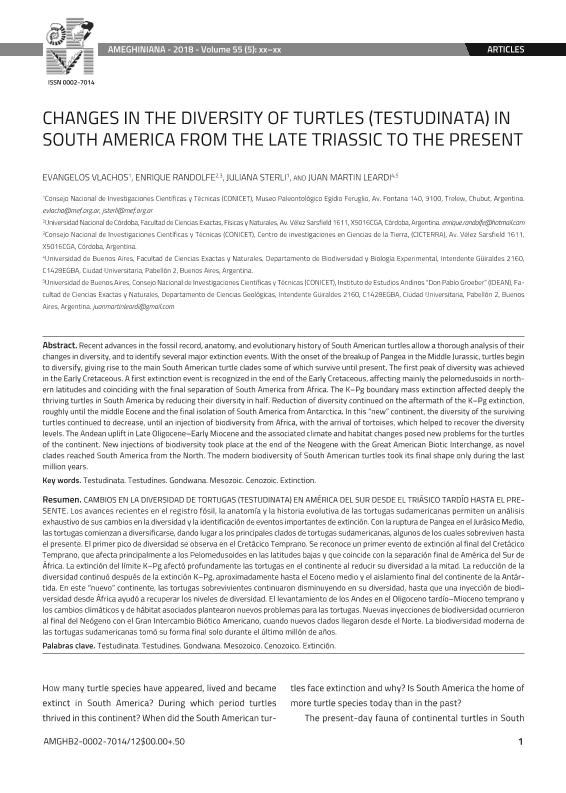Artículo
Los avances recientes en el registro fósil, la anatomía y la historia evolutiva de las tortugas sudamericanas permiten un análisis exhaustivo de sus cambios en la diversidad y la identificación de eventos importantes de extinción. Con la ruptura de Pangea en el Jurásico Medio, las tortugas comienzan a diversificarse, dando lugar a los principales clados de tortugas sudamericanas, algunos de los cuales sobreviven hasta el presente. El primer pico de diversidad se observa en el Cretácico Temprano. Se reconoce un primer evento de extinción al final del Cretácico Temprano, que afecta principalmente a los Pelomedusoides en las latitudes bajas y que coincide con la separación final de América del Sur de África. La extinción del límite K–Pg afectó profundamente las tortugas en el continente al reducir su diversidad a la mitad. La reducción de la diversidad continuó después de la extinción K–Pg, aproximadamente hasta el Eoceno medio y el aislamiento final del continente de la Antártida. En este “nuevo” continente, las tortugas sobrevivientes continuaron disminuyendo en su diversidad, hasta que una inyección de biodiversidad desde África ayudó a recuperar los niveles de diversidad. El levantamiento de los Andes en el Oligoceno tardío–Mioceno temprano y los cambios climáticos y de hábitat asociados plantearon nuevos problemas para las tortugas. Nuevas inyecciones de biodiversidad ocurrieron al final del Neógeno con el Gran Intercambio Biótico Americano, cuando nuevos clados llegaron desde el Norte. La biodiversidad moderna de las tortugas sudamericanas tomó su forma final solo durante el último millón de años. Recent advances in the fossil record, anatomy, and evolutionary history of South American turtles allow a thorough analysis of their changes in diversity, and to identify several major extinction events. With the onset of the breakup of Pangea in the Middle Jurassic, turtles begin to diversify, giving rise to the main South American turtle clades some of which survive until present. The first peak of diversity was achieved in the Early Cretaceous. A first extinction event is recognized in the end of the Early Cretaceous, affecting mainly the pelomedusoids in northern latitudes and coinciding with the final separation of South America from Africa. The K–Pg boundary mass extinction affected deeply the thriving turtles in South America by reducing their diversity in half. Reduction of diversity continued on the aftermath of the K–Pg extinction, roughly until the middle Eocene and the final isolation of South America from Antarctica. In this “new” continent, the diversity of the surviving turtles continued to decrease, until an injection of biodiversity from Africa, with the arrival of tortoises, which helped to recover the diversity levels. The Andean uplift in Late Oligocene–Early Miocene and the associated climate and habitat changes posed new problems for the turtles of the continent. New injections of biodiversity took place at the end of the Neogene with the Great American Biotic Interchange, as novel clades reached South America from the North. The modern biodiversity of South American turtles took its final shape only during the last million years.
Changes in the Diversity of Turtles (Testudinata) in South America from the Late Triassic to the Present
Título:
Cambios en la diversidad de tortugas (Testudinata) en América del Sur desde el triásico tardío hasta el presente
Fecha de publicación:
12/2018
Editorial:
Asociación Paleontológica Argentina
Revista:
Ameghiniana
ISSN:
1851-8044
e-ISSN:
1851-8044
Idioma:
Inglés
Tipo de recurso:
Artículo publicado
Clasificación temática:
Resumen
Palabras clave:
CENOZOIC
,
EXTINCTION
,
GONDWANA
,
MESOZOIC
,
TESTUDINATA
,
TESTUDINES
Archivos asociados
Licencia
Identificadores
Colecciones
Articulos(CICTERRA)
Articulos de CENTRO DE INVEST.EN CS.DE LA TIERRA
Articulos de CENTRO DE INVEST.EN CS.DE LA TIERRA
Articulos(IDEAN)
Articulos de INSTITUTO DE ESTUDIOS ANDINOS "DON PABLO GROEBER"
Articulos de INSTITUTO DE ESTUDIOS ANDINOS "DON PABLO GROEBER"
Articulos(SEDE CENTRAL)
Articulos de SEDE CENTRAL
Articulos de SEDE CENTRAL
Citación
Vlachos, Evangelos; Randolfe, Enrique Alberto; Sterli, Juliana; Leardi, Juan Martín; Changes in the Diversity of Turtles (Testudinata) in South America from the Late Triassic to the Present; Asociación Paleontológica Argentina; Ameghiniana; 55; 6; 12-2018; 619-643
Compartir
Altmétricas




